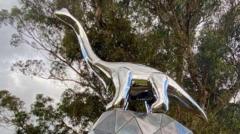The installation of "Boom Boom," a seven-meter stainless steel dinosaur sculpture in Taupō, New Zealand, has ignited a vibrant debate among locals, with reactions ranging from admiration to dissent, shedding light on community values and cultural investment.
Boom Boom Sparks Passionate Debate Over New Zealand Sculpture

Boom Boom Sparks Passionate Debate Over New Zealand Sculpture
A towering dinosaur sculpture in Taupō raises eyebrows and opinions
The recent unveiling of "Boom Boom," a seven-meter tall stainless steel dinosaur sculpture located in Taupō Sculpture Park, has stirred a whirlpool of opinions among local residents and visitors alike. The striking piece, commissioned by the Taupō Sculpture Trust, was crafted by Slovenian artist Gregor Kregar, who expressed his anticipation for the mixed reactions generated by the installation.
Within days of its arrival, Boom Boom, humorously nicknamed an “eyesaur” by some, has become a focal point for community discussion, illustrating the polarized views towards public art. Kregar noted that the intent behind the sculpture was to provoke engagement and reflections about art in public spaces, stating, "It's really hard to hate a sculpture of a dinosaur."
Opinions on social media reflect the divide: while one user praised the artwork for initiating conversations about art, others lamented the $100,000 investment derived from local taxpayers, arguing the funds could have supported other community needs. This funding was finalized in 2018, long before recent tax hikes from the Taupō District Council came into effect.
The artist also addressed criticisms regarding the sculpture's connection to Taupō itself. He explained that the rock foundation of Boom Boom was inspired by the region's dramatic volcanic landscape, particularly connected to Lake Taupō, a caldera that last erupted around 1,800 years ago. The sauropods, the dinosaurs that inspired Boom Boom, are believed to have roamed New Zealand millions of years ago, adding a layer of historical importance to the piece.
Kim Gillies, secretary of the Taupō Sculpture Trust, emphasized the thoughtful process behind the commission, defending it as a means to elevate Taupō's visibility in the art world. She asserted, "When it comes to the art, safe is a bit boring, right?"
As conversations continue, Kregar expressed hope that even those skeptical of the sculpture could grow to appreciate it, suggesting that over time, Boom Boom might become an integral part of Taupō's identity. "You put the sculpture out there, there is a reaction," he said, indicating that public art can evolve into beloved community symbols.
Within days of its arrival, Boom Boom, humorously nicknamed an “eyesaur” by some, has become a focal point for community discussion, illustrating the polarized views towards public art. Kregar noted that the intent behind the sculpture was to provoke engagement and reflections about art in public spaces, stating, "It's really hard to hate a sculpture of a dinosaur."
Opinions on social media reflect the divide: while one user praised the artwork for initiating conversations about art, others lamented the $100,000 investment derived from local taxpayers, arguing the funds could have supported other community needs. This funding was finalized in 2018, long before recent tax hikes from the Taupō District Council came into effect.
The artist also addressed criticisms regarding the sculpture's connection to Taupō itself. He explained that the rock foundation of Boom Boom was inspired by the region's dramatic volcanic landscape, particularly connected to Lake Taupō, a caldera that last erupted around 1,800 years ago. The sauropods, the dinosaurs that inspired Boom Boom, are believed to have roamed New Zealand millions of years ago, adding a layer of historical importance to the piece.
Kim Gillies, secretary of the Taupō Sculpture Trust, emphasized the thoughtful process behind the commission, defending it as a means to elevate Taupō's visibility in the art world. She asserted, "When it comes to the art, safe is a bit boring, right?"
As conversations continue, Kregar expressed hope that even those skeptical of the sculpture could grow to appreciate it, suggesting that over time, Boom Boom might become an integral part of Taupō's identity. "You put the sculpture out there, there is a reaction," he said, indicating that public art can evolve into beloved community symbols.



















